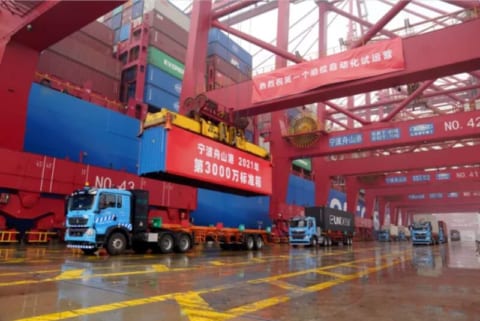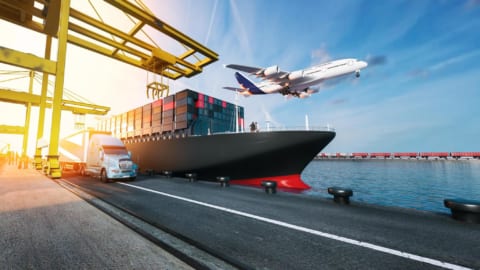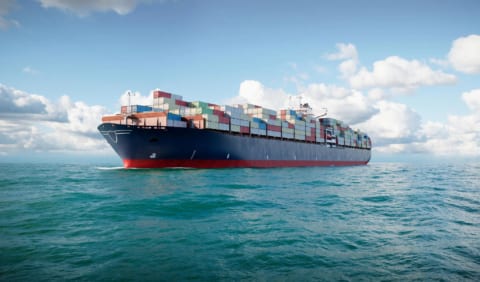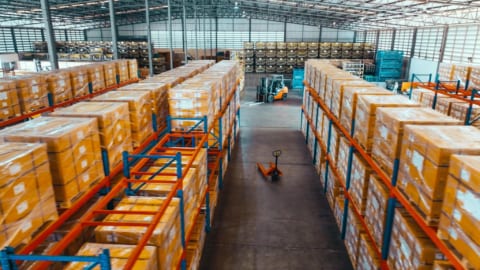Ningbo Zhoushan is in the third rank of the busiest container ports in the world. The port achieved a milestone in its development on 16 December, lifting 30,000,000 containers in 2021.
This incredible event determined Ningbo Zhoushan port’s position as the world’s third busiest container port complex. The achievement is outstanding as 15 years ago the port ranked 15th in the world, and also came in a year when the shipping operations were interrupted by a COVID-19 outbreak in August.
A ceremonial lift of the 30 millionth container took place in the Meishan Port District on the morning of December 16. The special container box was decorated and hoisted aboard the 20,000 TEU COSCO Shipping Pisces. To indicate the port’s success at automation, the command for the container lift was driven remotely, employed a remote-controlled bridge crane and a smart truck.

Ceremonial lift of the 30 millionth container on December 16, 2021 (Ningbo Zhoushan Port Company)
China is the top logistics hub that currently has seven of the 10 busiest container ports in the world. The Ningbo Zhoushan port complex experienced just over a 4% growth in volume in 2020 handling 28.7 million TEU. While it is among the fastest-growing sea ports in China, however, the port is far behind the global leaders- Shanghai and Singapore, which handled 43.5 million and nearly 37 million TEU in 2020 respectively.
The container shipping business of Ningbo Zhoushan Port began in the 1980s. According to the Chinese officials at the ceremony on 16 December, the first box was shipped on July 22, 1984, with the district handling just 323 TEU that year. In 1994, the container volume hit the record 100,000 and one million in 2001.
The noticeable development of the port came in 2005 with China’s decision to start large-scale construction projects and the integration of Ningbo and Zhoushan. The volume rapidly grew and by 2015 the port passed the 20 million TEU milestone. Officials point to the port’s increasing regional role and the essence of the port complex in China’s Belt and Road strategy for the region. China has greatly expanded rail links with Ningbo Zhoushan and is observing international multi-modal trains from the port.
The development of the port complex carries on with 27 new routes added in 2021 by the shipping lines which operate from Ningbo Zhoushan. The port is currently involved in 287 different routes. Besides, its facilities have been improved with new berths no.08 and no.09 at the Meishan Port Container Terminal this year. Also, the other terminals of the port complex have been upgraded and open additional new berths.
The Ningbo Zhoushan complex is also operated with highly automated systems and seeks to be a leader in digitalization. In the Meishan Port District, there is one terminal handling more than 2.6 million containers with automated operations, approximately 40% of its total volume.
 Modern automated system center of Ningbo Zhoushan port complex(Ningbo Zhoushan Port Company)
Modern automated system center of Ningbo Zhoushan port complex(Ningbo Zhoushan Port Company)
The entire port complex is proudly controlled by an independent hub with a domestically developed system- the first in use in this country. Port officials cited the high level of automation with the aim of helping to manage for example a 24% increase in the volume of empties arriving in the first ten months this year. One of the most effective keys among the operational modes is direct container loading at the port and direct container loading at the ship’s side. Port officials noted that this method helps eliminate the need for port storage and multiple loading and discharge for both import and export cargo.
Ningbo Zhoushan port complex is greatly efficient. It is reported by its officials that the average waiting time for international trade container vessels was just 30 hours in September, which was a cut of approximately 10 hours from August (this had been caused by the suspension of operations at the Meishan container terminal for nearly a couple of weeks as part of China’s zero-tolerance to COVID-19 pandemic). As the end of September, berthing time for the trunk line was stably controlled at about 23 hours, meanwhile, the berthing time in the both major international and domestic sea ports was announced to be relatively short.










